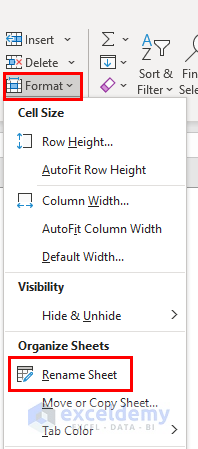5 Easy Ways to Rename Sheets in Excel

Managing spreadsheets efficiently is a critical skill in today's data-driven work environment. One of the foundational tasks in Excel that users frequently perform is renaming sheets. Whether you're organizing financial records, managing project timelines, or compiling large datasets, knowing how to effectively rename sheets can save time and enhance clarity. Let's explore five straightforward methods to rename sheets in Excel, ensuring you can streamline your workflow with ease.
Method 1: Double-click the Sheet Tab


The simplest way to rename a sheet in Excel is by double-clicking:
- Locate the sheet you wish to rename in the bottom tab area of your Excel workbook.
- Double-click on the sheet tab name to make the text editable.
- Type in your new sheet name and press Enter to save.
👉 Note: Ensure that your sheet name does not exceed 31 characters and does not include special characters like ‘:’, ‘?’, or ‘\’.
Method 2: Right-Click and Choose “Rename”


Here’s how you can rename a sheet using the context menu:
- Right-click on the sheet tab you want to rename.
- From the dropdown menu, select “Rename.”
- Now you can type a new name and press Enter to finalize the change.
Method 3: Using Keyboard Shortcuts

Keyboard shortcuts can save you time, especially when dealing with multiple sheets:
- To access the renaming feature, select the sheet tab.
- Press Alt+H + O + R in sequence. This will highlight the current name allowing you to edit it.
- Type the new name and press Enter.
👉 Note: This method might not work if you have modified the Excel keyboard shortcuts or are using a different language keyboard layout.
Method 4: Excel VBA Macro

If you often rename sheets with a specific pattern or batch rename, consider using a VBA macro:
- Open Excel and press Alt+F11 to open the VBA editor.
- In the editor, go to Insert > Module.
- Paste the following code into the module:
Sub RenameSheet()
Dim i As Integer
For i = 1 To ActiveWorkbook.Sheets.Count
ActiveWorkbook.Sheets(i).Name = “Sheet_” & i
Next i
End Sub
- Run the macro by pressing F5 or by selecting Run from the menu.
- The macro will rename all sheets sequentially.
👉 Note: Always backup your data before running macros to prevent any accidental data loss.
Method 5: Using Excel Ribbon Options


If you prefer using the Excel interface, here’s how to rename a sheet:
- Select the sheet tab you wish to rename.
- Navigate to the Home tab.
- In the Cells group, click on Format.
- Choose Rename Sheet from the dropdown menu.
- Type the new name and press Enter.
Incorporating these methods into your Excel workflow not only enhances your productivity but also helps in maintaining a well-organized workbook. Each technique has its own advantages, depending on the situation and your personal preference. Whether you're manually renaming one sheet or using VBA to automate the process, Excel offers flexibility that can cater to both novice and advanced users. By keeping your sheets named appropriately, you ensure clarity, making it easier for others or even for your future self to understand the workbook's structure and content at a glance.
Can I rename multiple sheets at once?

+
Yes, using VBA macros, you can rename multiple sheets simultaneously by applying the code to each sheet within a loop or by specifying the sheets explicitly.
What are the limitations when naming sheets?

+
Sheet names in Excel must be unique within a workbook, cannot exceed 31 characters, and special characters like :, ?, *, or \ cannot be used.
Is it possible to revert to the default sheet names?

+
Yes, you can revert to the default names like Sheet1, Sheet2, etc., by closing and reopening the workbook without saving changes or by using a VBA macro to rename sheets back to their original names.



